Group E of the Euros saw the biggest upset so far, with one of the lowest-ranked teams in the tournament, Slovakia, defeating Belgium, the third-ranked team in the world.
While Slovakia capitalised on their opportunity, Ukraine struggled with Romania dominating their meeting in game one. This group has been defined by surprises; our tactical analysis will provide an in-depth analysis of Slovakia’s success, Ukraine’s challenges, and what to expect in terms of the two teams’ tactics for their upcoming clash in game two.
Slovakia’s strengths
Slovakia, ranked 48th, achieved the remarkable by defeating one of the tournament favorites and highest-ranked teams globally. Their strategy? A structured 4-4-2 mid-block that seamlessly transitioned into a defensive 4-1-4-1 formation, effectively neutralising Belgium’s key midfielders. Stanislav Lobotka played a pivotal role for Slovakia, tasked with marking Kevin De Bruyne to disrupt Belgium’s passing lanes and limit his influence once in possession.
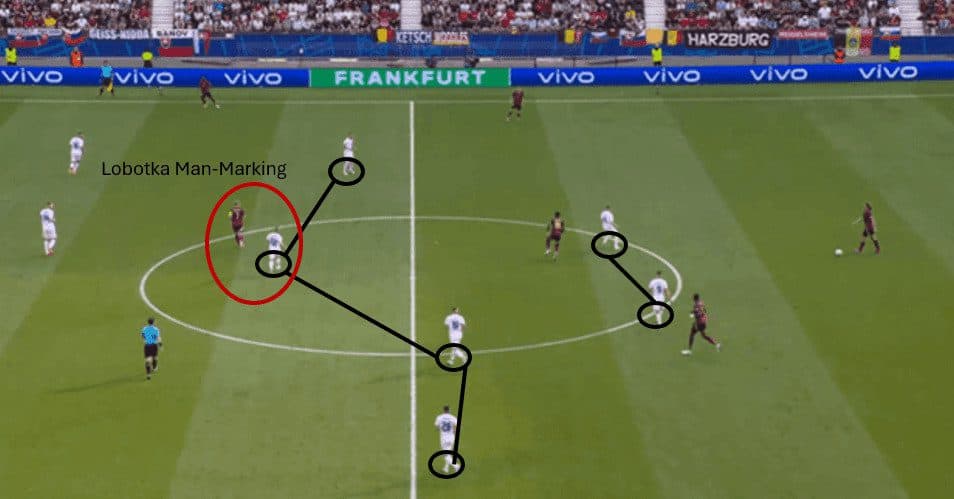
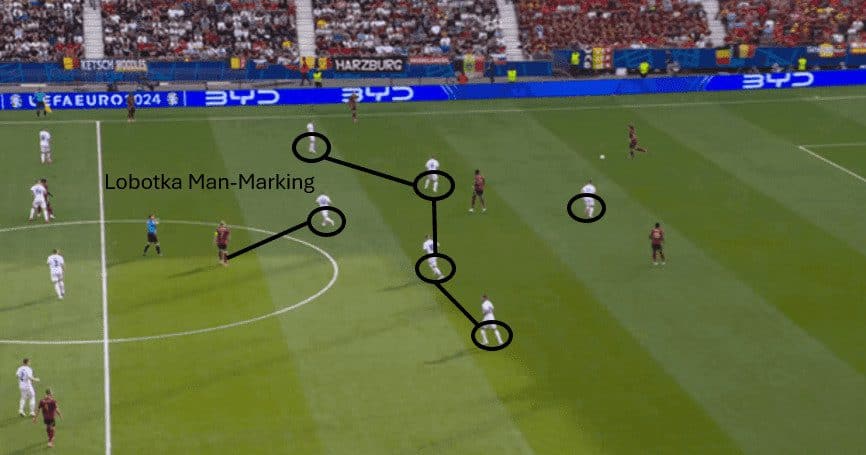
The two images above showcase the defensive structures Slovakia relied on: a makeshift 4-4-2 that could transition into a 4-1-4-1 and vice versa.
This flexibility allowed Slovakia to maintain a four-player line in their secondary defensive layer when they decided to sit back as Belgium advanced into their half. During Belgium’s build-up from the back, starting with their goalkeeper, Slovakia switched to a 4-1-4-1, enabling Lobotka to man-mark Kevin De Bruyne while maintaining a second defensive line of four players.
This strategy caused Belgium considerable difficulty in the first half. They were frequently frustrated by Slovakia’s mid-block, forcing them to depend on individual brilliance from players like Doku, Carrasco, and Kevin De Bruyne to penetrate the Slovak structure.
The Key Man: Stanislav Lobotka
Lobotka was the central figure for Slovakia. He was assigned the challenging role of man-marking Kevin De Bruyne and intercepting other passing lanes to mitigate Belgium’s midfield dominance. He has been a crucial player not only for Slovakia but also for Napoli. Below is a graphic of the player’s radar chart, highlighting his strengths, particularly in accurate passing and defensive duel rate.

Below is the graphic illustrating his defensive territory for the season in Serie A with Napoli. Notably, he only played 722 minutes this season, indicating that our sample size is relatively small.

When comparing the graphic above with those below, a similarity becomes apparent: the number of interceptions high up the field. Observing the ball recoveries against the Belgian team, we see three counter-pressing ball recoveries just in the opponent’s half. The player excelled at disrupting the Belgian build-up not only in his own half but also in the opponent’s, a trait not commonly seen in defensive midfielders anymore.
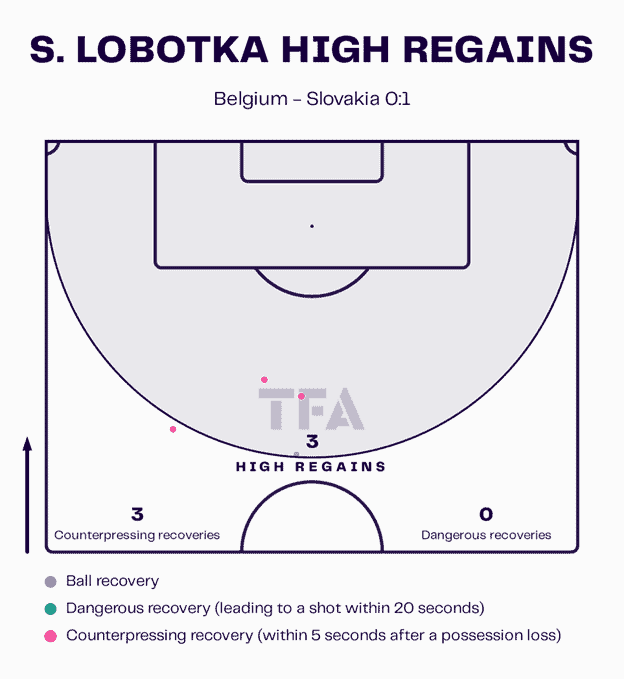
The heatmap below is quite impressive, showing that Lobotka was nearly everywhere on the field. Focusing primarily on central areas, he closely marked Kevin De Bruyne, who also operated in central zones. The heatmap indicates high intensity in these areas where Lobotka was active. His comprehensive presence was crucial in shutting down Belgium’s build-up and attacking transitions, ultimately proving key to Slovakia’s victory in this match.
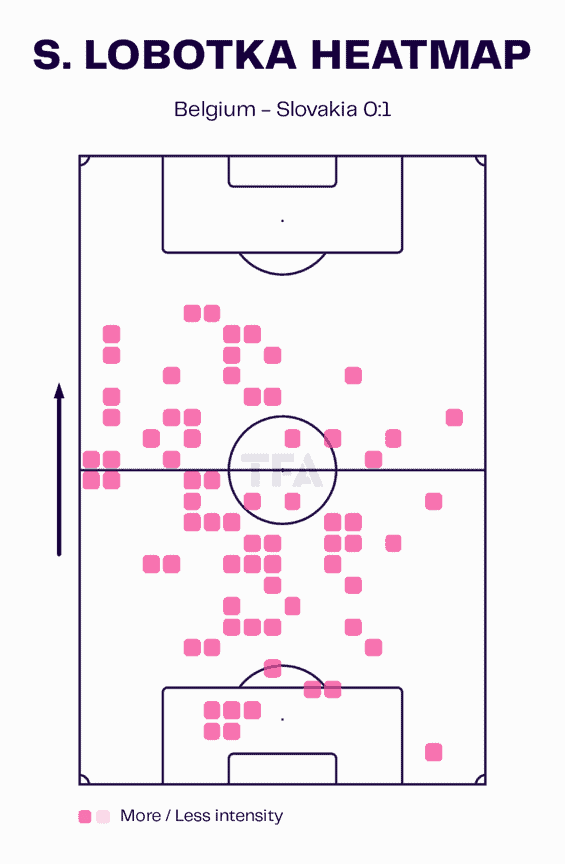
Overall, Slovakia successfully disrupted Belgium’s build-up in the first half, largely due to Lobotka’s exceptional performance, effectively neutralizing Kevin De Bruyne and the rest of the Belgian team. In the second half, the same pattern occurred, but Belgium managed to penetrate Slovakia’s structure more consistently. However, they ultimately failed to convert their chances on goal, which cost them the match and awarded Slovakia the three points.
Ukraine’s weaknesses
Coming into this tournament, many considered Ukraine a dark horse, boasting talents like Andriy Lunin, Oleksandr Zinchenko, Mykhailo Mudryk, and Artem Dovbyk, which seemingly positioned them to impress on the global stage. However, to the surprise of many, Romania ran riot over Ukraine, scoring three goals in the opening match of their campaigns. So, where did Ukraine falter? Their weak spot was defensive concentration.
Looking at the first image below, we see the ball at the feet of a Romanian player, following a mistake by Lunin during the build-up. The Romanian player then has a clear chance at goal and finishes his opportunity brilliantly. There isn’t much to analyse here other than it being a significant error by the goalkeeper. In international tournaments like this, a single-goal mistake can drastically change the dynamics of the game. In international football, mounting a comeback after falling behind is much more challenging than in club football due to the heightened stakes and pressure. This sequence not only set Ukraine back early but also likely inflicted psychological damage that affected their performance for the rest of the match.
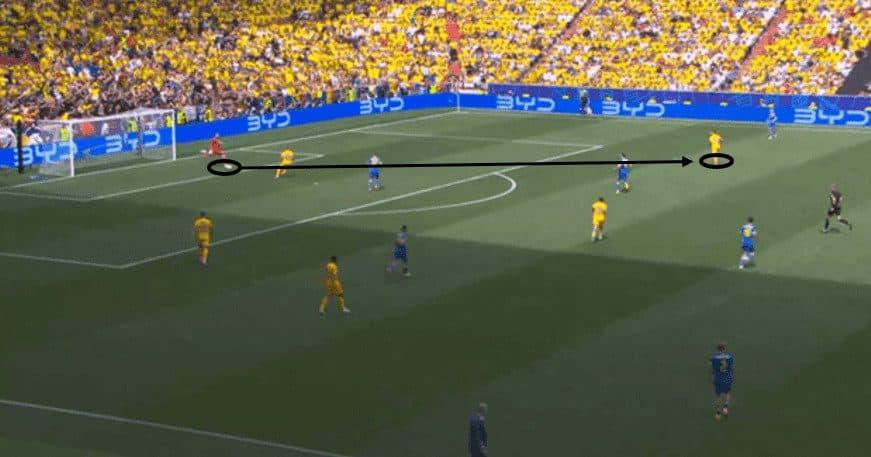
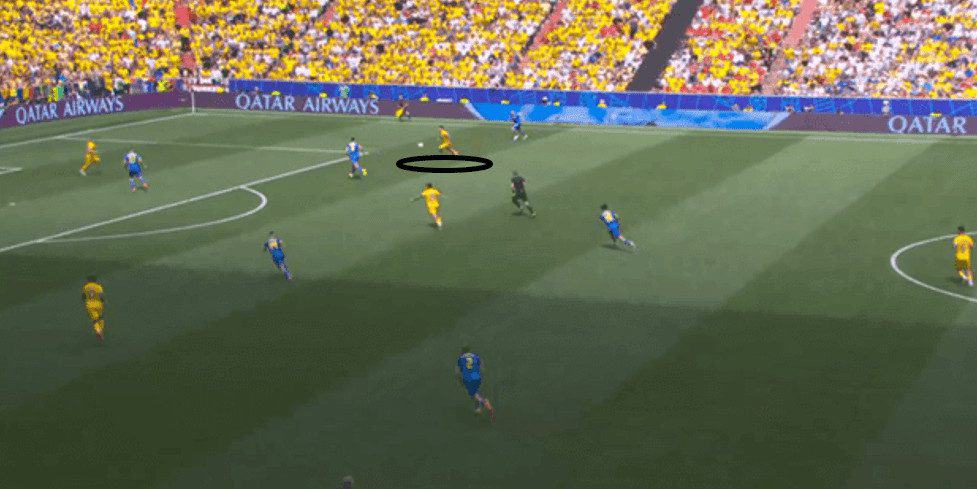
The second goal highlighted Ukraine’s struggles during transitions, which allowed Romania to attack effortlessly. In the first image below, we see a Romanian player pressured by two Ukrainian players following a loss of possession from a Ukrainian throw-in. Remarkably, the Romanian player manages to evade both Ukrainian defenders before releasing the ball to another teammate, as depicted in the second image, to push the attack even further. This sequence exemplifies Ukraine’s challenges in regaining control and effectively managing defensive transitions.
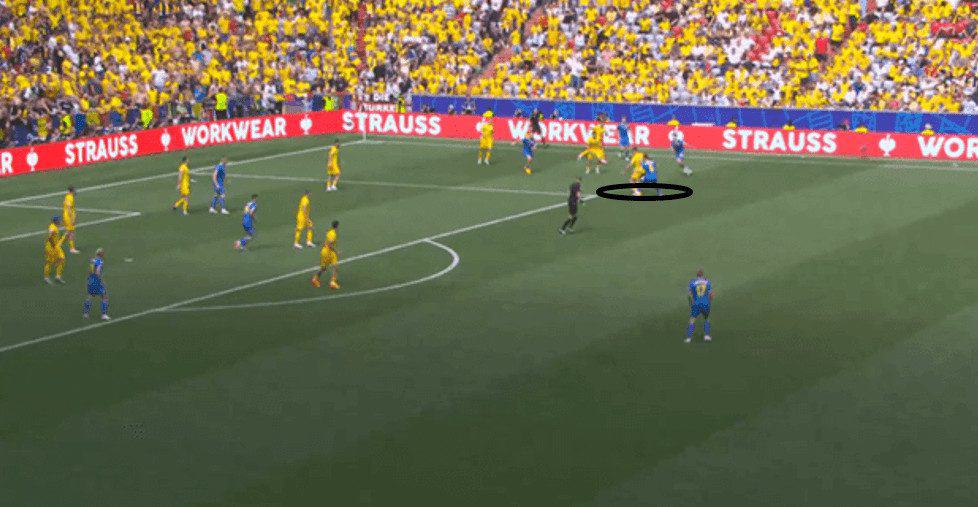
In the image below, we observe an imbalance in Ukraine’s defensive positioning, with six Ukrainian players clustered on the right side of the pitch. In contrast, two Romanian attackers advance with the ball on the opposite side. These two Romanian players execute a swift sequence with a single pass, moving the ball to the centre just outside the 18-yard box. From there, the ball is powerfully struck into the back of the net. This moment underscores Ukraine’s tactical disarray and poor spatial coverage, allowing the Romanian team to exploit the open space effectively.
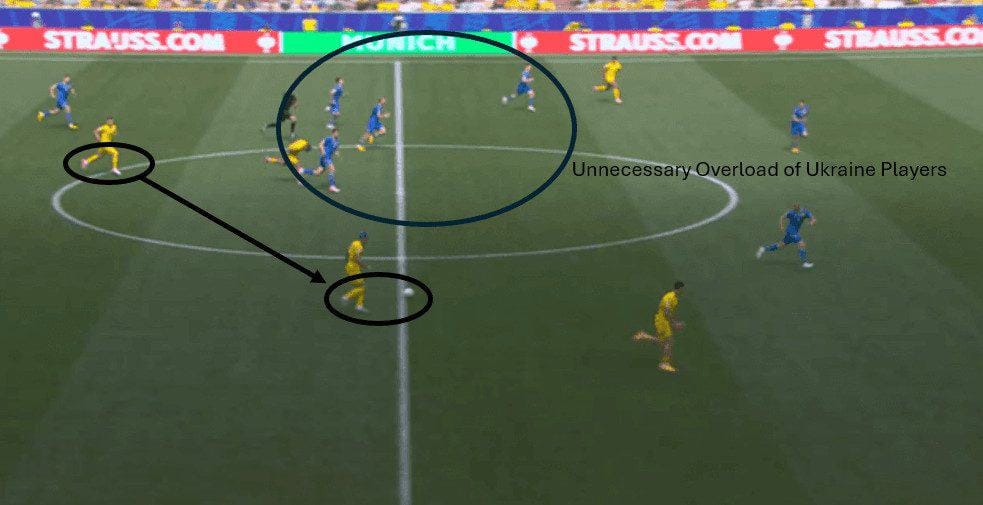
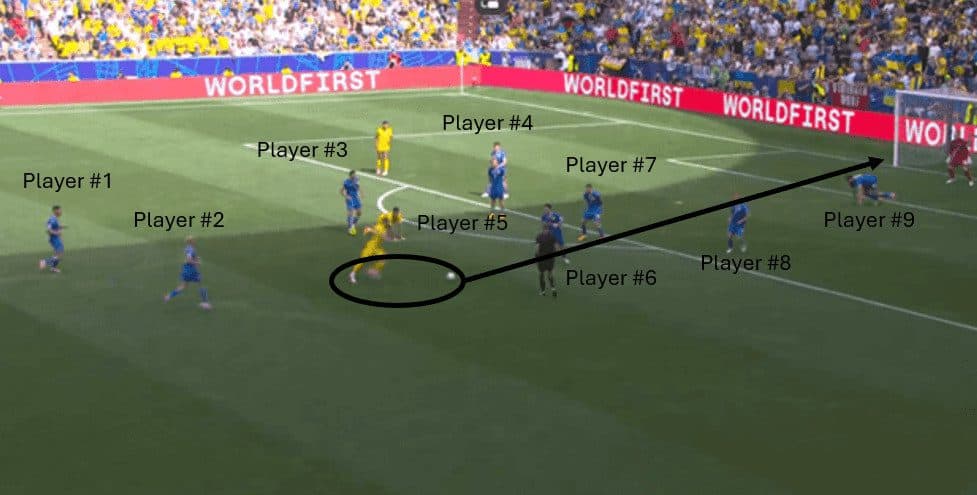
In the third image above, the ball is perfectly positioned for Razvan Marin to strike cleanly. It’s noteworthy that there are four Romanian players involved in this attack (three visible in this image and one on the right wing who is out of frame) despite there being nine Ukrainian players present. This highlights Ukraine’s primary weakness: defensive transitioning and defensive fortitude/concentration.Despite having numerical superiority, Ukraine could not effectively organize or respond, allowing Romania to execute a rapid counterattack. Starting deep in their own half, Romania managed to exploit Ukraine’s disorganized transition defence, culminating in a goal—all within roughly 18 seconds. This sequence exemplifies how critical effective defensive transitions are in preventing quick counterattacks.The lack of defensive concentration also contributed to the third goal conceded by Ukraine. A short corner was taken, allowing the Romanian player to effortlessly move into open space and square the ball to his teammate for an open net. As shown in the two images, the Ukrainian players appear lethargic and lack the urgency needed to close down the attacking player. This recurring issue of poor concentration and effort allowed the opponent to navigate through an overloaded defensive setup with ease, illustrating a fundamental flaw in Ukraine’s defensive strategy during the match.
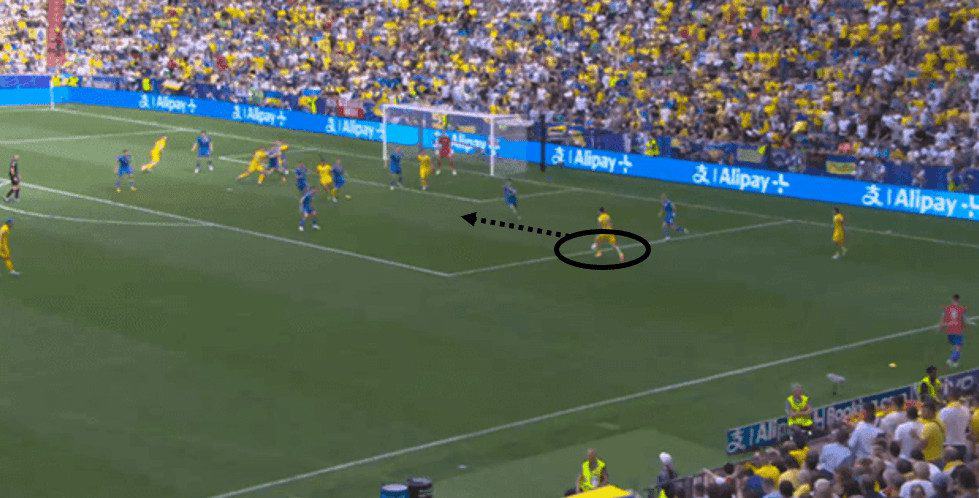
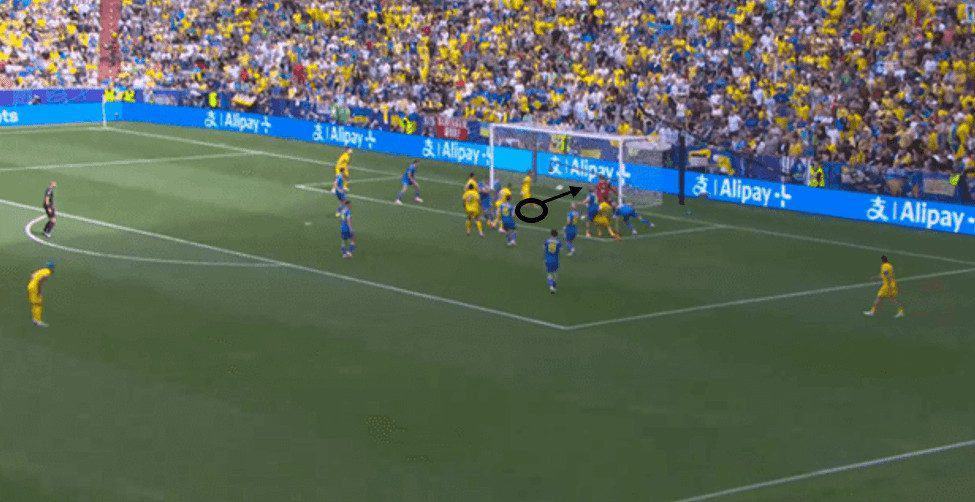
Notice that the second and third goals highlighted a significant issue. Despite having more Ukrainian players than Romanian attackers in both instances, Romania moved through Ukraine’s defensive transitions and blocks with surprising ease. It’s as if Ukraine played casually, almost unaware they were in a competitive match. This lack of alertness and poor defensive organization must be addressed moving forward. If these issues persist, Ukraine risks conceding a high number of goals in their upcoming matches, which could severely impact their performance in the tournament. Although one can make a case that the Ukrainian players may have given up after the second goal, hence the laziness in defending the third Romanian goal.
Ukraine vs Slovakia
This match promises to be a fascinating battle. It features a Ukrainian team known for its talented attackers and dynamic offensive sequences against a Slovakian squad renowned for its robust defensive structure and aggressive high pressing. The clash of these contrasting styles should make for an engaging and tactical encounter, as each team leverages its strengths and counters the opponent’s strategies.
Standout players in this upcoming match will likely include Lobotka, who will once again be pivotal in disrupting Ukraine’s attacking build-up. Meanwhile, Mykhailo Mudryk could thrive in a wide range of areas of the field. His play style is reminiscent of Jeremy Doku’s performance, where Doku completed 25 carries, with eight being progressive and 11 attacking take-on. This comparison is relevant because both Mudryk and Doku share similar attributes: confident ball-handling, dribbling speed, pace, and the ability to manipulate their body to evade defenders. Slovakia showed vulnerabilities in wide zones where players like Carrasco and Doku exploited space effectively.
In contrast, Mudryk is likely to exploit similar spaces in front of him, using his ability to create opportunities through his dynamic movements and progressive runs. Below is a graphic illustrating how effective Mudryk was with the ball against Romania, where he frequently engaged in take-ons and made progressive runs.

Slovakia demonstrated their capability to hold possession and create attacking chances in the first half against Belgium, but they also showed their ability to absorb pressure and quickly counterattack their opponents. Ukraine, based on their first match, struggled with defensive concentration, which ultimately costed them.The opening match of such a major campaign can be nerve-racking for any team, and if Ukraine can improve on their defensive focus, they should be able to hold off any counterattacks from Slovakia. Both teams have the ability to sit deep defensively while also holding possession and looking to break down the opposition.





Comments